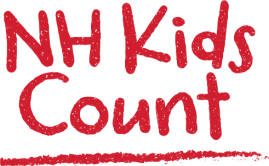Economic stability is fundamental to a child's ability to thrive, yet too many New Hampshire families are struggling to make ends meet. Rising costs are squeezing families from every direction: the median home price has soared to $540,000, average rent has jumped 31 percent since 2020, and food prices have climbed 25 percent in just five years. These pressures leave nearly half of renter households cost-burdened, contribute to an estimated 3,605 children experiencing homelessness, and force families to make impossible choices between housing, food, and child care. The toxic stress of poverty impacts brain development, health outcomes, and children's long-term opportunities, making economic security not just a financial issue but a critical foundation for every child's future.
Child Poverty by County
In New Hampshire, nearly 1 in 15 children lives in poverty.
- Child poverty refers to the share of children under age 18 who live in families with incomes below the federal poverty level. Compared to other states, New Hampshire has a high median household income and a low official poverty rate. Yet in 2023, one in four households in New Hampshire had incomes below $50,000.1
- The poverty threshold for a family of three with two adults and one child is an annual income of $26,556 in 2025.2 Yet, the Massachusetts Institute of Technology’s Living Wage Calculator estimates the statewide cost of living for a family with two working adults and one child in New Hampshire is $104,373 per year, which includes typical expenses like food, child care, housing, medical, transportation, and internet access.3
- Coos County (rural) has the highest rate of poverty in the state at 16 percent (over 800 children). Rockingham County (non-rural) has the lowest occurrence of poverty at 5.1 percent (approximately 3,000 children).4 Rural areas tend to have fewer job opportunities and more barriers to obtaining high-wage work, like a lack of dependable child care, lower education levels, lack of internet access, and transportation challenges.5
![]()
Data Spotlight
Growing Up in Poverty
The toxic stress from growing up in poverty can change how the brain develops. Poverty is considered an Adverse Childhood Experience (ACE). According to the CDC, 1 in 6 adults experienced four or more types of ACEs, which have been linked to chronic health problems, mental illness, and substance misuse in adulthood.
Household Income
Income gaps affect children being raised by single parents across the state.
- In New Hampshire, the median annual household income with children is $125,496, but this varies significantly by county and household type. Median annual family income is lowest in Coos County at $84,248, and highest in Rockingham County at $153,341. Statewide, families with single fathers have average household incomes of $73,233, which is 47 percent more than the average family income of households led by single mothers ($49,587).6 Both of these median incomes are below the living wage.
- Since 2017, income has risen considerably for two-parent families and families with single dads, while it has remained largely stagnant for single mothers. The average two-parent household earned $43,665 more in 2023 than it did in 2017, while single-mother households saw an increase of only $17,482 over the same period.7 Only 31 percent (6,000) of households headed by an unmarried woman receive child support.8 Approximately 8,000 children live in households where no adults work.9
- In New Hampshire, women earn only 76 cents for every dollar earned by men. Additionally, women hold an estimated 90.8 percent of all child care jobs and approximately 86.4 percent of the home health services jobs—two occupations that are commonly paid wages below the state’s median hourly wage of $24.10However, these jobs often have flexible hours, benefiting single mothers and other households limited to working during school hours if they cannot afford additional childcare.
![]()
Data Spotlight
Child Care Workforce
In 2024, the average child care worker earned $34,570 per year, and an estimated 9.4 percent of New Hampshire’s child care workforce were living at or below poverty levels in 2022. Low wages and lack of benefits may contribute to high turnover rates, leading to an eight percent reduction in the New Hampshire child care workforce from 2023 to 2024. A reduction in the child care workforce causes fewer available child care slots for the entire state. An estimated 28% of child care workers, including those employed by Head Start, currently rely on Medicaid for their health insurance. In 13 states more than one-third of the child care workforce depends on Medicaid.
Housing
Rising housing costs are impacting families across New Hampshire.
- In New Hampshire, 77 percent of children (approximately 194,000 children) live in homes that are owned, either with a mortgage or owned free and clear.12 This means that 23 percent of children live in rental homes. In 2024, renter households spent 31 percent more per month than they did in 2020, as the average rent increased from $1,283 per month in 2020 to $1,691 per month in 2024,13 far outpacing average household income growth of 25 percent.
- Households spending more than 30% of their income on housing costs and utilities are cost-burdened; those spending more than half of their income are severely cost-burdened. In 2023, 47.6 percent of renter households in New Hampshire were cost-burdened, compared to just 27.9 percent of homes owned with a mortgage and 19.4 percent of homes owned outright.14
- Rising rental prices are associated with an increase in homelessness. Studies show that a $100 increase in median rent is associated with a 9% increase in the estimated homelessness rate.15 In New Hampshire, an estimated 3,605 children enrolled in public schools were homeless. Homelessness in infancy and toddlerhood has been linked to delays in social and emotional skill development, lower levels of academic achievement, and higher rates of behavioral problems.16
![]()
Data Spotlight
Housing
Costs
In May 2025, the median sale price of a single-family house in New Hampshire reached a record high of $540,000 for the second time. Concurrently, the National Association of Realtors’ Affordability Index dropped to a record low 55, meaning the state’s median household income is just 55 percent of what is necessary to qualify for a $540,000 home under current interest rates. By comparison, the Index was as high as 200 in 2013 and was over 100 in 2021. According to a study by NHAR, families earning $100,000 per year can afford only 19 percent of homes for sale in New Hampshire.17
Food Insecurity
For families to thrive, they must have access to quality food at all times.
- The U.S. Department of Agriculture (USDA) defines food security as “access at all times to enough food for an active, healthy life for all household members.” Food insecurity in children is associated with issues in language development, school performance, social interactions, and reduced physical growth potential, overall health, poor sleep quality, mental health disorders, and a higher probability of chronic disease.18
- In January 2023, New Hampshire expanded income eligibility for SNAP to 200 percent of the federal poverty line. An estimated 14,815 households with children receive Supplemental Nutrition Assistance Program (SNAP) benefits in New Hampshire.19 However, statewide, nearly 250,000 households are eligible for SNAP. According to New Hampshire Hunger Solutions, only 31 percent of eligible households enroll in SNAP benefits.20 This could be due to stigma, limited awareness about eligibility, complex application processes, or language barriers.
- Inflation plays a critical role in food security. The Consumer Price Index for urban consumers in the northeastern United States estimates food prices in January 2024 were 25.6 percent higher than they were in January 2019.21 This limits a household’s ability to access enough food at all times, forcing them into less-healthy food choices, which can affect childhood development.
![]()
Solving Problems Through Policy Change
SNAP Farmers Market Program
The Granite State Market Match program expands SNAP/EBT benefits for fruits and vegetables at farmers' markets, farm stands, and CSAs. This program, championed by New Futures in 2023, helps households access more fresh fruits and vegetables and also supports local farmers. Each budget cycle, state lawmakers introduce efforts to underfund or cut this critical program.
Policy Considerations
To improve the economic well-being of children and families, New Hampshire should adopt policies that:
- •Expand nutrition assistance programs like universal school meals and WIC.
- •Ensure equitable access to affordable housing by incentivizing the construction of affordable housing units, supporting local zoning reforms, and increasing support for the Affordable Housing Fund.
- •Support a strong child care workforce with investments in proven recruitment and retention strategies like training programs, scholarships, and tuition assistance for child care workers.
References
- Sletton, P. (2025, April 16). Get the facts about poverty in New Hampshire. New Hampshire Fiscal Policy Institute. https://nhfpi.org/blog/explainer-get-the-facts-about-poverty-in-new-hampshire/
- U.S. Department of Health and Human Services, Office of the Assistant Secretary for Planning and Evaluation. (n.d.). 2025 Poverty Guidelines: 48 Contiguous States (all states except Alaska and Hawaii).
- Living Wage Calculator - Living wage Calculation for New Hampshire. (n.d.). https://livingwage.mit.edu/states/33
- Children in poverty | KIDS COUNT Data Center. (n.d.). https://datacenter.aecf.org/data/tables/10280-children-in-poverty?loc=31&loct=5#detailed/5/4430-4439/false/2545/764/19906,19907
- Melotte, S. (2023, December 15). Rural jobs grew a percentage point in September, but the Longer-Term trend is still a problem. The Daily Yonder. https://dailyyonder.com/rural-jobs-grew-a-percentage-point-in-september-but-the-longer-term-trend-is-still-a-problem/2023/12/06/
-
Median family income by family type | KIDS COUNT Data Center. (2025, January). Retrieved July 1, 2025, from https://datacenter.aecf.org/data/tables/10278-median-family-income-by-family-type?loc=31&loct=5#detailed/5/4430-4439/false/2545/6344/19903
- Median family income by family type | KIDS COUNT Data Center. (2025, January). Retrieved July 1, 2025, from https://datacenter.aecf.org/data/tables/10278-median-family-income-by-family-type?loc=31&loct=5#detailed/5/4430-4439/false/2545/6344/19903
- Female-headed families receiving child support | KIDS COUNT Data Center. (2024, September). Retrieved July 7, 2025, from https://datacenter.aecf.org/data/tables/10453-female-headed-families-receiving-child-support?loc=31&loct=2#detailed/2/31/false/2554,2479,2097,1985,1757,1687/any/20156,20157
- Children living in low-income households where no adults work | KIDS COUNT Data Center. (2025, February). Retrieved July 8, 2025, from https://datacenter.aecf.org/data/tables/5046-children-living-in-low-income-households-where-no-adults-work?loc=31&loct=2#detailed/2/31/false/2545,1095,2048,1729,37,871,870,573,869,36/any/11450,11451
- Williams, J., & Heller, N. (2025, March 24). Spotlight on Granite State women in the labor Force for National Women’s Equal Pay Day. New Hampshire Fiscal Policy Institute. Retrieved July 2, 2025, from https://nhfpi.org/blog/spotlight-on-granite-state-women-in-the-labor-force-for-national-womens-equal-pay-day/
- New Hampshire Fiscal Policy Institute. (2025c, May 26). Workforce for early childhood care and education declined 8 percent in 2024, child care tuition rates remain high - New Hampshire Fiscal Policy Institute. https://nhfpi.org/resource/workforce-for-early-childhood-care-and-education-declined-8-percent-in-2024-child-care-tuition-rates-remain-high/
- Children living in households that are owned | KIDS COUNT Data Center. (n.d.). https://datacenter.aecf.org/data/tables/4755-children-living-in-households-that-are-owned?loc=31&loct=2#detailed/2/31/false/2545,1095,2048,1729,37,871,870,573,869,36/any/11121,11122
- Median monthly gross rental cost | KIDS COUNT Data Center. (2025, January). Retrieved July 2, 2025 from https://datacenter.aecf.org/data/tables/8765-median-monthly-gross-rental-cost?loc=31&loct=2#detailed/2/any/false/1096,2048,574,1729,37,871,870,573,869,36/any/17588
- Share of homes that are cost-burdened | KIDS COUNT Data Center. (2025, January). Retrieved July 2, 2025, from https://datacenter.aecf.org/data/tables/10293-share-of-homes-that-are-cost-burdened?loc=31&loct=2#detailed/2/any/false/2545,2048,574,1729,37,871,870,1983,1607/6371,6372,6373/19922
- Homelessness: Better HUD oversight of data collection could improve estimates of homeless population. (n.d.). U.S. GAO. https://www.gao.gov/products/gao-20-433
- Kull, M., Dworsky, A., Horwitz, B., F. Farrell, A., & Chapin Hall at the University of Chicago. (2019). Developmental consequences of homelessness for young parents and their children | ZERO TO THREE. ZERO TO THREE, 62. https://www.zerotothree.org/resource/journal/developmental-consequences-of-homelessness-for-young-parents-and-their-children/
- Price record equaled | News. (2025, June 8). New Hampshire REALTORS. Retrieved July 2, 2025, from https://nhar.org/news/article/may-market-2025
- New Hampshire Fiscal Policy Institute. (2024a, March 5). Poverty and food insecurity in New Hampshire during and following the COVID-19 crisis - New Hampshire Fiscal Policy Institute. https://nhfpi.org/resource/poverty-and-food-insecurity-in-new-hampshire-during-and-following-the-covid-19-crisis/
- Households with children receiving Supplemental Nutrition Assistance Program benefits | KIDS COUNT Data Center. (2025, February). Retrieved July 7, 2025, from https://datacenter.aecf.org/data/tables/10292-households-with-children-receiving-supplemental-nutrition-assistance-program-benefits?loc=31&loct=2#detailed/2/any/false/2545,1095,2048,574,1729,37,871,870/6370/21313,19921
-
NH Hunger Solutions. (n.d.). NH Hunger Solutions. Retrieved July 8, 2025, from https://nhhungersolutions.org/data/
-
New Hampshire Fiscal Policy Institute. (2024b, March 5). Poverty and food insecurity in New Hampshire during and following the COVID-19 crisis - New Hampshire Fiscal Policy Institute: Food insecurity during the COVID-19 pandemic. https://nhfpi.org/resource/poverty-and-food-insecurity-in-new-hampshire-during-and-following-the-covid-19-crisis/




